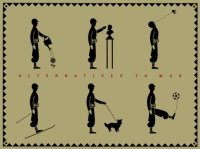
I am not going to forgive Kaayva Viswanathan, but I'm not going to pile on her either. Writers steal from each other all the time—and borrow, cite, allude, and pay homage. The lines between these are fluid, and more often plagiarism is subjective than objective. Many of the passages most recently cited as plagiarism in the Harvard Independent's most recent article are examples more of borrowing and allusion than outright theft. It's extrememly difficult—basically impossible—to know the seriousness of Viswanathan's transgressions without having the books in front of you, so the letters to the NY Times and others tend to ring false.
Especially interesting to me is this letter, reprinted here in its entirety:
To the Editor:
It comes as no surprise to any faculty member who uses writing as part of the curriculum to learn that yet another author has been caught plagiarizing. It is an old problem that is rampant in contemporary society.
So, too, are the claims that such acts were unintentional or caused by undue pressure to perform in the classroom or on the job.
Interestingly, those who get caught never confess that the benefits they gained by cheating were also unintentional.
Copying the work of another is a conscious act. It is unacceptable without proper attribution. It is also increasingly easy to discover.
When that happens, faculty, editors, publishers and institutions of higher learning must deal with plagiarists swiftly and publicly.
As such, we are deeply indebted to those who brought to light the case of Kaavya Viswanathan. She will be a good example of the fate of plagiarists next semester.
George M. Garrity
Terence L. Marsh
East Lansing, Mich., April 25, 2006
The writers teach microbiology and molecular genetics at Michigan State University.
For more reading: Slate has a good explanation of Viswanathan and the marketing culture behind chick-lit.
Qui Custodes Ipsos Custodiet?
That said, a number of articles about Viswanathan use strikingly similar language, especially now that her novel has been pulled and this has become a larger story.
"Publisher spurns Viswanathan's apology," an AP article from USA Today, probably written by Andrew Ryan:
Viswanathan's novel tells the story of Opal, a hard-driving teen from New Jersey who earns straight A's in high school but who gets rejected from Harvard because she forgot to have a social life. Opal's father concocts a plan code-named HOWGAL (How Opal Will Get A Life) to get her past the admissions office.
"'Mehta' Has Passages Similar to '01 Book," by Andrew Ryan of AP:
Viswanathan's novel tells the story of Opal, a hard-driving teen from New Jersey who earns straight A's in high school but who gets rejected from Harvard because she forgot to have a social life. Opal's father concocts a plan code-named HOWGAL (How Opal Will Get A Life) to get her past the admissions office.
"Sadness and Glee at Harvard Writer's Fall," also from Andrew Ryan of AP:
Viswanathan's book tells the story of Opal, a hard-driving teen who earns all A's in high school but gets rejected from Harvard because she forgot to have a social life. The heroine bears superficial similarities to the author, including Indian heritage, a New Jersey upbringing and Harvard.
"Publisher won't buy chick-lit writer's apology," from Howard Gensler of the Philadephia Daily News:
Viswanathan's novel tells the story of Opal, a teen from New Jersey who excels in high school but who gets rejected from Harvard because she forgot to have a social life.
"Lawyers called in over star author's 'accidental' copying," from the Times of London by Lee Glendinning "and agencies" (which I presume means AP):
The 320-page novel tells the story of Opal, a hard-driving young woman who gains straight A's in high school but gets rejected from Harvard because she forgot to have a social life. Her father concocts a plan which he codenames HOWGAL (How Opal Will Get A Life) to get her past the admission’s office.
Three of these are from the AP news service, and the two others have bylines with caveats:a At the end of Gensler's article, you see these words: "Daily News wire services contributed to this report," and as I noted earlier, Glendinning's byline contains an allusion to "agencies."
What Glendinning and Gensler do—taking words verbatim from a wire report—doesn't bat eyes at some, perhaps many, papers. It may even be allowed by the contract that each paper has with AP, UPI, Reuters, and whatever else comes in from reports. Nonetheless, what Gensler and Glendinning have done—again, not necessarily even violating the ethics codes at their papers—is ethically dubious at best.
The long and short of it is that neither Gensler nor Glendinning wrote that part of the article. Period. This is different than using wire reports for research, or public quotations—it's taking someone else's actual writing. The problem may very well by systemic; unfortunately I don't know enough about daily newspaper operations to know how prevalent this is.
As far as I'm concerned, Gensler and Glendinning must either (a) include Andrew Ryan's name on the byline; or (b) rewrite the paragraph and keep the reference to "wire services" or "agencies," as it was those agencies that told them what they were writing about. Let me again cite the letter from the two Michigan State Professors (emphasis mine):
Copying the work of another is a conscious act. It is unacceptable without proper attribution. It is also increasingly easy to discover.
When that happens, faculty, editors, publishers and institutions of higher learning must deal with plagiarists swiftly and publicly.
"Unacceptable without proper attribution"—a newspaperman may argue that proper attribution has been given by the references to agencies and wire reports. I argue that each person has a right to recognition of their own work. If I write a paper and my entire bibliography says:
1. Sources—Books, Journal articles, Internet research
it would never pass muster. The words Gensler and Glendinning used were not their words, so they need to give credit to the person whose words those are.
I also include those three excerpts from different AP articles because Ryan appears to be cribbing from himself. I'm not going to moralize on this point, unlike those other articles, because I'm not sure it's wrong from a consequentialist or utilitarian viewpoint. I do find it interesting, however.
To sum up, we have (I believe) the original AP author; the AP author cribbing from himself, twice; and Lee Glendinning and Howard Gensler cribbing from him in a way that often overlooked but morally dubious at best.
Little, Brown's Ad Copy
I have a Little, Brown catalog sitting on my shelf, so just for fun, here's the ad copy for the novel (all sic):
Since Opal's birth, the Mehtas have raised their only daughter with one goal in mind: to get into Harvard. They even concocted a rigorous game plan they called HOWGIH—How Opal Will Get Into Harvard. There were flowcharts, diagrams, and endless lists to track her progress. At 16, Opal is her high school's valedictorian, presiden of three honor societies, and first chair in the regional orchestra. She even took welding classes to appear well-rounded. Her admission to Harvard looks like a sure thing.
But at Opal's interview with Harvard's Dean of Admissions, he sets aside her impressive resume and asks the one question she never saw coming: What do you like to do for fun? Opal flubs the interview, but the Dean offers her another chance—if she can show that she is more than her GPA. Opal and her parents respond to this setback with the same rigor, calculation, and focus they applied to creating the perfect academic resume, and design a whole new plan: HOWGAL—How Opal Will Get A Life.
The Mehtas excel at anything they set their mind to, and Opal's calculated rise on her high school's social ladder—full of pop-culture cramfests, fashion makeovers, and a semester of nonstop partying—leaves Opal impossibly popular…and very confused. For the first time in her life, Opal finds herself asking two fundamental questions: "Who am I, and what do I love to do?"
In this brilliant and outrageously funny debut novel, Opal's journey is a delight from the first page to the last.


